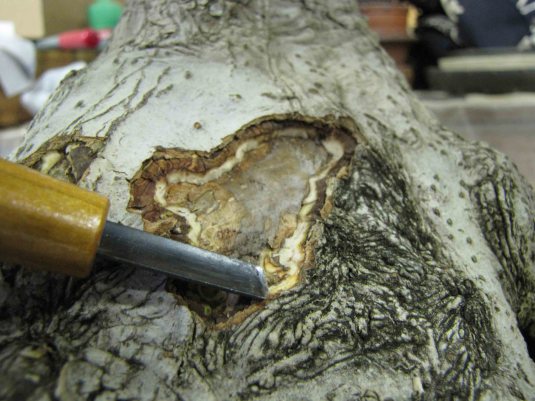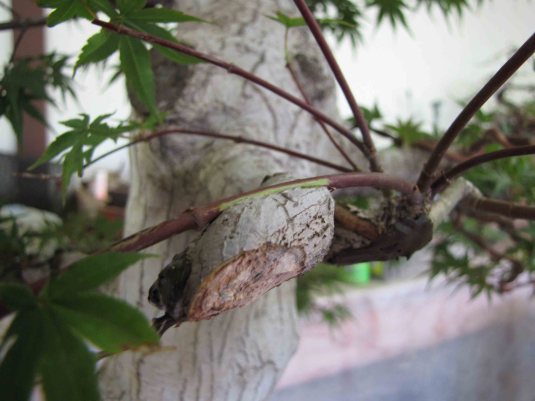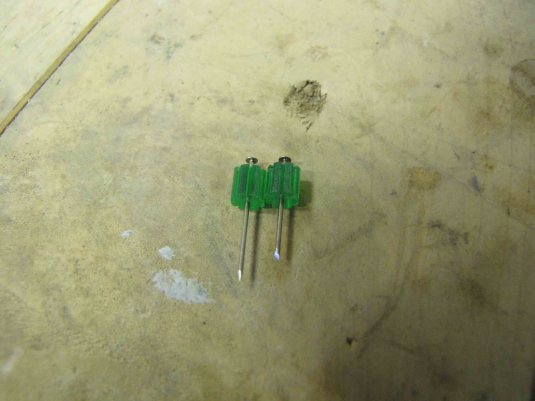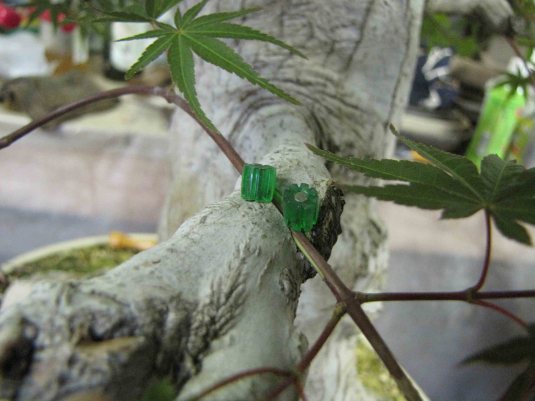This posts was originally written and posted by Peter Tea, a third year Bonsai Apprentice at Aichi-en Bonsai Nursery in Japan. He is an exceptional writer and explains things in a very clear and exciting way. Anyone that follows his posts knows we all wait collectively in anticipation for the email that comes alerting us all there is new one to read!! Enjoy this one!
Now that all the defoliating has been done to the refined trees here at Aichien, it was time to work on the project trees. This time, Mr. Tanaka tasked me with this large Japanese maple that is being redeveloped. All the branches growing on the tree have been grafted with a better leaf quality. The tree was allowed to grow during the Spring and now that Summer is right around the corner, this was a good time to continue it’s development. The goal at this point is to wire the new branches and graft three areas that need branches. In this post, I will talk about the grafting technique I used, wound management and a hint about defoliating.
 Here is a side by side of the original leaf (1 left) on the tree versus the new leaf (2 right) that has been grafted on. The reason why leaf 1 was replaced is because it has a rounded droopy appearance a opposed to leaf 2. Overall, a tree that has leaf 1 tends to look wilted all the time whereas leaf 2 has a more upright and healthy feeling that most of us are accustomed too with a Japanese Maple. Of course, because of the lack of popularity with leaf 1, the price of the tree is much lower then if it had leaf 2. So for all these various reasons, the leaf was changed.
Here is a side by side of the original leaf (1 left) on the tree versus the new leaf (2 right) that has been grafted on. The reason why leaf 1 was replaced is because it has a rounded droopy appearance a opposed to leaf 2. Overall, a tree that has leaf 1 tends to look wilted all the time whereas leaf 2 has a more upright and healthy feeling that most of us are accustomed too with a Japanese Maple. Of course, because of the lack of popularity with leaf 1, the price of the tree is much lower then if it had leaf 2. So for all these various reasons, the leaf was changed. and here is an example of a maple that has a more desirable leaf characteristic. Personally, I wouldn’t mind having both styles. ;o)
and here is an example of a maple that has a more desirable leaf characteristic. Personally, I wouldn’t mind having both styles. ;o)
What is Approach Grafting ? and Some Terms
Approach grafting is pretty much using two self sustaining branches and fusing them together. In this case, I’m going to take some of the long branches from one part of this tree and attaching it to another part of the tree. The nice thing about approach grafting is that both branches are still being feed so there isn’t any water flow cut off. The chances of a successful union are much higher and reliable with an approach graft.
The best time to do an approach graft is during the growing season.
Here are a few terms that I will use to explain the approach graft operation:
Scion- The new branch I used for grafting
Stock- The branch I’m grafting on to
Graft union- the point where the Scion and Stock are attached.
 Also, knowing a few tree plant biology terms wouldn’t hurt either. You’ll hear me use the word Cambium a lot. That is the area of the scion and stock that have to meet to achieve successful graft.
Also, knowing a few tree plant biology terms wouldn’t hurt either. You’ll hear me use the word Cambium a lot. That is the area of the scion and stock that have to meet to achieve successful graft.
Lets Get to Work!
 Before I start on the grafting, I took care of two wounds on the base of the trunk. We found this dead area under the bark and needed to take some steps to help it continue to callus and close up. As in previous post, I took a sharp gouge and lightly cut into the surrounding callus. This will help reactive it and its continued growth. I then applied a good amount of liquid cut paste to seal it all up.
Before I start on the grafting, I took care of two wounds on the base of the trunk. We found this dead area under the bark and needed to take some steps to help it continue to callus and close up. As in previous post, I took a sharp gouge and lightly cut into the surrounding callus. This will help reactive it and its continued growth. I then applied a good amount of liquid cut paste to seal it all up.
One importuning thing that people don’t really talk about is the hard surface that a callus needs to grow on. In this case, the surface is the hard wood. Sometimes, this hardwood can be soft or rotted out because of exposure to water or humidity. If that was the case on this tree, the callus will grow slightly and stop. If we find a deciduous tree that has a rotted out wound, we would have to dig the rotted wood out and fill it with a hard putty or cement to give the callus a firm surface to form on. Luckily, this time, the hard wood is still hard.
On With the Grafting!
 The first thing I did was look through the tree and figure out where I needed new branches. Here is an example of an area that I need to add a branch.
The first thing I did was look through the tree and figure out where I needed new branches. Here is an example of an area that I need to add a branch. Once I decided where to graft, I used a sharp clean saw to make the cut. The depth of the cut is dependent on how thick the scion branch is. In this case, the cut was not very deep. Note how the cut is green. This tells me that the area is alive and able to take a graft. If I cut into the stock branch and saw only brown dry wood, obviously I would have to find a different area to graft. Next, I took a sharp clean grafting knife and slightly enlarged the cut to make it wide enough to accept the scion branch.
Once I decided where to graft, I used a sharp clean saw to make the cut. The depth of the cut is dependent on how thick the scion branch is. In this case, the cut was not very deep. Note how the cut is green. This tells me that the area is alive and able to take a graft. If I cut into the stock branch and saw only brown dry wood, obviously I would have to find a different area to graft. Next, I took a sharp clean grafting knife and slightly enlarged the cut to make it wide enough to accept the scion branch. Here I placed the scion branch into the stock to check for fit. Note how the scion branch is green at the graft union?
Here I placed the scion branch into the stock to check for fit. Note how the scion branch is green at the graft union? For a better chance of a successful graft, I lightly scraped away the bark to exposed the cambium layer. If I can match the scion branch cambium with the stock branch cambium the graft will take faster.
For a better chance of a successful graft, I lightly scraped away the bark to exposed the cambium layer. If I can match the scion branch cambium with the stock branch cambium the graft will take faster. Once I feel that the fit of the graft union is good, I used a small nail with a rubber pad to hold the scion in place. Note where the nail is positioned.
Once I feel that the fit of the graft union is good, I used a small nail with a rubber pad to hold the scion in place. Note where the nail is positioned. I then lightly hammered the nails down so that the rubber portion is pressing the scion branch down into the stock branch. Then I added a second nail to hold the other end of the scion branch down. Once the scion was secured, I applied liquid cut paste to all exposed areas. Graft finished!
I then lightly hammered the nails down so that the rubber portion is pressing the scion branch down into the stock branch. Then I added a second nail to hold the other end of the scion branch down. Once the scion was secured, I applied liquid cut paste to all exposed areas. Graft finished!
Here’s Another Example
 Again, I found another area that needs a new branch. I used my saw and grafting knife to cut the groove in the stock branch. In this picture, I placed the scion branch in the groove to check for fit. The groove I cut ended up being a little bit too deep but it’s not a huge problem because deciduous trees in general callus easily and the scion and stock cambium will fuse together even it they aren’t exactly lined up.
Again, I found another area that needs a new branch. I used my saw and grafting knife to cut the groove in the stock branch. In this picture, I placed the scion branch in the groove to check for fit. The groove I cut ended up being a little bit too deep but it’s not a huge problem because deciduous trees in general callus easily and the scion and stock cambium will fuse together even it they aren’t exactly lined up. Here’s a great shot of how only the green rubber portion is holding the scion down. When hammering the nail down I needed to be careful to not applying too much pressure and crushing the scion branch.
Here’s a great shot of how only the green rubber portion is holding the scion down. When hammering the nail down I needed to be careful to not applying too much pressure and crushing the scion branch. I applied a liberal amount of liquid cut paste to seal all open wounds. The cut paste is important because it will help seal in the moisture that is needed for callus to form quickly and easily.
I applied a liberal amount of liquid cut paste to seal all open wounds. The cut paste is important because it will help seal in the moisture that is needed for callus to form quickly and easily. After the I applied the cut paste, I then wired the scion branch with aluminum wire and put some movement on the branch. After an approach graft is a good time to wire the branch as well because once the graft takes, the scion branch might be too thick to wire or put unnecessary stress on the graft union. It would a shame to spend the time to graft, have it take, then kill the branch by applying wire to it. Doing it now when everything is fresh is best.
After the I applied the cut paste, I then wired the scion branch with aluminum wire and put some movement on the branch. After an approach graft is a good time to wire the branch as well because once the graft takes, the scion branch might be too thick to wire or put unnecessary stress on the graft union. It would a shame to spend the time to graft, have it take, then kill the branch by applying wire to it. Doing it now when everything is fresh is best.
Also note how short the internode between the graft union and the first node of the scion branch is. We need to take into consideration the internode lengths when placing the graft because we don’t want to do all this work just to find out the grafted branch internode is too long later.
 I continued to wire the rest of the branches and put some movement in them. I cut many of the branches shorter on top because I didn’t need the branches to get much thicker there. I left the bottom branches long because I need them to continue to thicken. In 6-12 months I will revisit this tree and see if the grafts were a success!
I continued to wire the rest of the branches and put some movement in them. I cut many of the branches shorter on top because I didn’t need the branches to get much thicker there. I left the bottom branches long because I need them to continue to thicken. In 6-12 months I will revisit this tree and see if the grafts were a success! For those have have these nifty nails to use for approach grafts, the left nail is the normal length and the right nail is a modified length. Maple live wood can be very hard so driving a thin nail into it can be difficult. Because of that, I took a old pair of concave cutters and slightly shortened them so that they can still be effective in holding the scion branch down but doesn’t require me to nail so deep into the heartwood.
For those have have these nifty nails to use for approach grafts, the left nail is the normal length and the right nail is a modified length. Maple live wood can be very hard so driving a thin nail into it can be difficult. Because of that, I took a old pair of concave cutters and slightly shortened them so that they can still be effective in holding the scion branch down but doesn’t require me to nail so deep into the heartwood.
Some of you might be wondering, “where can I find those nails with the rubber on them?” Me and several people have tried finding these nail in the US with no luck. They seem to only be available in Japan. They are mainly used to nail boards onto a frame and come in various lengths and thickness. For the time being, it looks like if we’re going to use these nails for approach grafting, we either have to make them ourselves import it from Japan. If you the reader knows of a local place to get it, please share it with everybody in the comment section below. You would be doing me and everybody else a favor!
Defoliating Maples
In Bonsai, we hear the word defoliate many times, especially with maples. Defoliating a maple is pretty much the removal of all the leaves during the growing period. Note how the Maple I just worked on was not defoliated. Defoliation seems to be talked about so much that if people don’t defoliate their trees, they feel that they’re missing something very important when perhaps their tree doesn’t need it. Though defoliation is a great technique when used properly, we have to realize when and when not to use it. In my next post, I will talk more in depth about the concept of defoliation and the desired results of it. In the mean time, think about the reasons for defoliation and when it should and should not be done. Once you’ve pooled your thoughts together about defoliating, we’ll meet back here and I’ll share with you my thoughts on the technique and its uses.
 In the next post, I’ll do some defoliation on this tree and show some examples of the many others that I’ve done in Aichien. Do you remember this tree?
In the next post, I’ll do some defoliation on this tree and show some examples of the many others that I’ve done in Aichien. Do you remember this tree? If not, this is what the tree looked like in the middle of last April. Yes! It’s one of my project trees. If you would like to know the story behind it, you can visit the original post about it by clicking Here.
If not, this is what the tree looked like in the middle of last April. Yes! It’s one of my project trees. If you would like to know the story behind it, you can visit the original post about it by clicking Here.



No comments:
Post a Comment